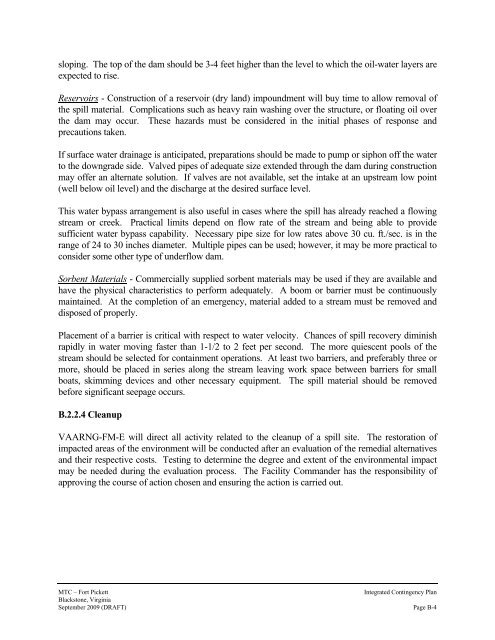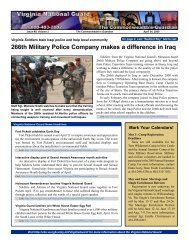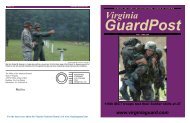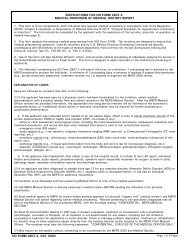INTEGRATED CONTINGENCY PLAN Maneuver Training Center
integrated contingency plan maneuver training center fort pickett ...
integrated contingency plan maneuver training center fort pickett ...
- No tags were found...
You also want an ePaper? Increase the reach of your titles
YUMPU automatically turns print PDFs into web optimized ePapers that Google loves.
sloping. The top of the dam should be 3-4 feet higher than the level to which the oil-water layers are<br />
expected to rise.<br />
Reservoirs - Construction of a reservoir (dry land) impoundment will buy time to allow removal of<br />
the spill material. Complications such as heavy rain washing over the structure, or floating oil over<br />
the dam may occur. These hazards must be considered in the initial phases of response and<br />
precautions taken.<br />
If surface water drainage is anticipated, preparations should be made to pump or siphon off the water<br />
to the downgrade side. Valved pipes of adequate size extended through the dam during construction<br />
may offer an alternate solution. If valves are not available, set the intake at an upstream low point<br />
(well below oil level) and the discharge at the desired surface level.<br />
This water bypass arrangement is also useful in cases where the spill has already reached a flowing<br />
stream or creek. Practical limits depend on flow rate of the stream and being able to provide<br />
sufficient water bypass capability. Necessary pipe size for low rates above 30 cu. ft./sec. is in the<br />
range of 24 to 30 inches diameter. Multiple pipes can be used; however, it may be more practical to<br />
consider some other type of underflow dam.<br />
Sorbent Materials - Commercially supplied sorbent materials may be used if they are available and<br />
have the physical characteristics to perform adequately. A boom or barrier must be continuously<br />
maintained. At the completion of an emergency, material added to a stream must be removed and<br />
disposed of properly.<br />
Placement of a barrier is critical with respect to water velocity. Chances of spill recovery diminish<br />
rapidly in water moving faster than 1-1/2 to 2 feet per second. The more quiescent pools of the<br />
stream should be selected for containment operations. At least two barriers, and preferably three or<br />
more, should be placed in series along the stream leaving work space between barriers for small<br />
boats, skimming devices and other necessary equipment. The spill material should be removed<br />
before significant seepage occurs.<br />
B.2.2.4 Cleanup<br />
VAARNG-FM-E will direct all activity related to the cleanup of a spill site. The restoration of<br />
impacted areas of the environment will be conducted after an evaluation of the remedial alternatives<br />
and their respective costs. Testing to determine the degree and extent of the environmental impact<br />
may be needed during the evaluation process. The Facility Commander has the responsibility of<br />
approving the course of action chosen and ensuring the action is carried out.<br />
MTC – Fort Pickett<br />
Integrated Contingency Plan<br />
Blackstone, Virginia<br />
September 2009 (DRAFT) Page B-4
















